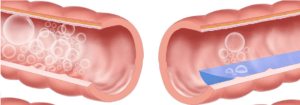
Nuestro organismo produce entre 0,6 y 1,8 litros de gas al día de manera normal. Imagina una botella de 1,5 litros de agua… ésa es la cantidad aproximada de gas que producimos. Sin embargo, esta cantidad es tremendamente variable dependiendo de la cantidad y tipo de microorganismos que cada uno tenemos en nuestro aparato digestivo, nuestra MICROBIOTA INTESTINAL. Este gas es liberado por vía oral y rectal, como todos sabemos, pero también una gran parte de estos gases difunden desde el intestino al torrente sanguíneo, siendo transportados a los pulmones y liberándose durante la respiración.
En nuestra boca y colon (intestino grueso) residen de forma habitual bacterias productoras de hidrógeno, fundamentalmente, que lo producen cuando fermentan los carbohidratos procedentes de la dieta. Cuando se detecta hidrógeno en el aliento de un paciente, éste procede de la fermentación bacteriana, puesto que nuestras células no son capaces de producirlo.
Las personas con sobrecrecimiento bacteriano o SIBO se caracterizan por tener bacterias también colonizando el intestino delgado. Estos pacientes producirán mucho más hidrógeno que la media y notarán distensión abdominal, ruidos en el abdomen, flatulencias, etc.
Sin embargo, hay pacientes con estos mismos síntomas que, al realizarles un test de aliento en el que solo se mide hidrógeno, éste no se encuentra incrementado… Esto suele deberse a que el intestino del paciente está colonizado también por otro microorganismo, las Archaeas.
Las Archaeas son productoras de metano, y lo fabrican a partir de la fermentación de los carbohidratos de la dieta, y del hidrógeno que producen sus bacterias vecinas. Por tanto, cuando hay Archaeas, es habitual que el hidrógeno no se encuentre demasiado elevado porque ha sido consumido.
Así, un paciente con sintomatología de sobrecrecimiento bacteriano (gases, flatulencias) que se realice un test de aliento para ser diagnosticado, podría tener el hidrógeno en valores normales (lo que podría ser malinterpretado como un diagnóstico negativo) y, sin embargo, tener un sobrecrecimiento de Archaeas que le está generando ese incremento en los gases intestinales. Por tanto, es esencial medir tanto la concentración de hidrógeno como la de metano para alcanzar un diagnóstico correcto.
Recuerda, si tienes que hacer un test de aliento para diagnosticar a tu paciente, o tienes que someterte a un test de aliento para diagnosticar una intolerancia o un sobrecrecimiento bacteriano, SIEMPRE hay que analizar los dos gases.